 [1]This wasn’t the article I had been planning on doing for today, but it is in the vein of articles I’ve been thinking about for a while. The comments and feedback on Martin’s State of The Stew [2] article are pretty thought provoking to us here at the Stew. Reading the multiple opinions that proclaim meat over meta, I’ve been looking at my writing style. It would be an injustice to say I am only friends with meta when thinking about gaming. We have likely shared a few intimate dinners that fade off into silhouettes in the moonlight.
[1]This wasn’t the article I had been planning on doing for today, but it is in the vein of articles I’ve been thinking about for a while. The comments and feedback on Martin’s State of The Stew [2] article are pretty thought provoking to us here at the Stew. Reading the multiple opinions that proclaim meat over meta, I’ve been looking at my writing style. It would be an injustice to say I am only friends with meta when thinking about gaming. We have likely shared a few intimate dinners that fade off into silhouettes in the moonlight.
I don’t intend to abandon writing articles about ideas, concepts, and trends in games, but I am going to examine my writing style a bit and determine if meat would suit some articles better than meta. To that end, I’m going to take a series of articles I’ve been planning and rework them into a series called Meet The Meat Of My Game. I’m currently running a Fudge game [3] based off of a 4e module by Wolfgang Baur. I’ve gotten permission from my players to use it in Gnome Stew Articles, so I’m going to start adding some show to my tell. This post is going to be a quick introduction to the game and what I’m doing with it. Other posts in the series are going to be about specific things I’ve done with the game and will tie into various gaming ideas and tactics and how they are actually used at the table. I’m doing this as an experiment to see how it works as a series of articles and how people like it. That means I’d love your feedback on the article and the game. Keep one thing in mind with this article, it’s an introduction. It is mostly show and is very picture heavy. Without any further ado, meet my game.
Courts Of The Shadow Fey-ish
I’ve mentioned this before in the post where I try to decide between Fudge and Savage Worlds [4]for the system, but this is that the game is about. A faery (more grimm, less disney) court returns to a small city in America that was founded primarily by Irish, Welsh, English and Scottish immigrants. The Duke who funded the expedition traded with a faery king for favor and good fortune for the city in the new world. The fey helped the city get established and then promptly forgot about it for a few hundred years. When they came back in the present day, they found the city completely different and without the Duke’s family in charge. Seeing this as a violation of the treaty, they have taken over the city and clouded the minds of most of the people to their ownership. The PCs are normal-ish humans who have some miniscule supernatural affinity that lets them get past the glamour and act as representatives of the city to the courts. Their goal is to join the courts, gain status, and save the city from a cruel fate.
Why Fudge?
Ok, so the first meat in the stew pot of my game was the system I was going to be running it in. The adventure module was written for 4e, but that didn’t fit my group’s play style. We also decided to play this in modern times, as we’d all kind of burned out on sword and sorcery-esque fantasy. I debated the merits of my top 2 system choices, Fudge or Savage Worlds over here [3], but in the end I chose Fudge for a few reasons.
- The malleability of the system allowed me to give players lots of freedom in character choice. The players became more focused on the characters were rather than the powers and abilities they could have.
- While going with Fudge required a lot of initial work on my part to craft the system specifics, I was able to create something from the Fudge rules that fit my view of the game world. I was able to choose which attributes would be used and didn’t have to work against skills or options that might have been mentioned but don’t fit the theme of the game. I can also common sense anything the players throw at me. My players can’t rules lawyer, because the rules are 12 pages and entirely up to my (and their) interpretation. This was by design and isn’t meant to limit options, but to expand them. If a player wants a certain type of power that isn’t covered in some source book, we can whip it up on the fly.
- With Fudge being so open and up to my interpretation, I’m able to say things just happen with much less thought than I could in a more established system. Since it isn’t a 4th level teleportation spell or a high level edge, the players don’t start calculating what could do that and at what level that puts the enemy.That last part was what made me choose fudge. Since the game is faery based, there are a lot of things that happen based on story logic or weird rules that have a completely alien logic to them. My prep involves much less choosing the right mechanical option and much more figuring out how to keep the game fun and interesting.
How We Organize The Players
While the use of a modified Fudge system makes my system prep easier, we’ve done a lot of prep to help players keep track of the many, many elements going on at once. First off, every player gets a folder that contain the following:
- Character Sheet
- A complete copy of the rules (they only come to 12 pages)
- An index card cheat sheet for easy reference of the rules
- The folder acts as a means to keep track of other handouts or things the players get during the course of the game.
 [6]The group also gets a Group folder. It contains a full color map of the city and holds the many handouts that the group gets. We might ditch this in favor of everyone getting a copy of each handout or storing group items differently. Most of my handouts so far haven’t been 8 by 11 sized, but we’ll talk about that later. To the right you can see the character sheet. Click on it to see the full sized one.
[6]The group also gets a Group folder. It contains a full color map of the city and holds the many handouts that the group gets. We might ditch this in favor of everyone getting a copy of each handout or storing group items differently. Most of my handouts so far haven’t been 8 by 11 sized, but we’ll talk about that later. To the right you can see the character sheet. Click on it to see the full sized one.
One thing we are doing is avoiding the use of traditional minis. Combat and action scenes aren’t even flirting with gridded tactical play, but it is sometimes nice to get an idea of layouts. To that end, we’ve used tokens, vis a vis Newbie DM’s [7] article and Patrick’s article [8] that built on Newbie DM’s original work. Here are the tokens that represent the main characters.
Here is a very abstract representation of a road through a forest. Some mapping is likely to get more detailed, but most will function in this way.
We had a guest star in one game. She played a pooka, so we made her a very special character sheet. She dictated to us her skills in a series of barks and woofs. We have no idea what any of it means though. I’ve included this only because the dog is really really cute and it gives you an idea of the very relaxed play atmosphere we have going on.
Behind The Screen
Ok, that is what the game looks like from the players’ perspective. Here is what it looks like from mine.
I use a customizable GM’s screen and arrange various things behind it. It starts out blank, then important elements get put into the side panels for quick reference. The adventure module stays out and open for easy reference, but so does my binder that contains important info, like the sheet of NPC names and my mini-character sheets. My binder contains practically everything for the game, and I’m going to talk about GM organization methods in another post. The mini character sheets have proven invaluable. They help me keep track of how characters are built and help me to build or tweak challenges to particular characters. When I ask someone to roll something, I can look over their character and decide what skill or gift would work best.
Names List                                               Mini Character Sheets
Another tool I’ve been using is a mini calendar. With 4 months to a page, I can keep track of in-game dates and events with some simple notation. Combined with a simple notes page in my binder, I can build a timeline when I write an adventure log. This type of thing wouldn’t be nearly as important in most fantasy games, but keeping track of the days of events has become fairly important to the immersion factor of this modern era game. Being able to go back and say “No, that was September 7th when you witnessed the river freezing over.” is very important. Merely connecting that in-game fantastical element to a realistic date makes the group feel much more immersed into the game world.
While everything at my table is paper (to avoid the disrupting feel of electronics at the table), I also use an Obsidian Portal wiki to chronicle and keep track of things. I’m going to share the link with a caveat in 2 parts. Being a personal campaign, it gets enough polish to eek by and I don’t kill myself trying to make sure every image is CC licensed or public domain. You’ve been warned. http://www.obsidianportal.com/campaigns/to-the-waters-and-the-wild [16]
Index Cards, Index Cards, Index Cards
This one is going to get a whole article, and probably pretty soon. Index cards are the spine and backbone of my game. I use index cards for everything. In the picture below you can see my item index cards, my item template index cards, my mini NPC sheets, the blank index cards that I use for a million and one things, and you can get a glimpse of the 4 by 6 “NPC cards” I’m using to help players keep track of the incredible number of NPCs. What isn’t visible are the index cards I use to plot out things using the 3-3-3 method [17], the ones that hold notes to myself for later, or the ones I use to pass notes to players secretly or draw quick terrain sketches on.
I keep all of the cards in a 4 by 6 card holder box and organize them with tabs. One box and one binder hold my entire campaign. Another box holds the tokens I’ve made. It is VERY nice to keep everything neatly contained.
Ok, one final thing I’m going to talk about in this intro. My game has a LOT of NPCs. The NPCs are VERY important and players are rarely good at keeping track of who each NPC is. To that end, I put in a lot of time to make a deck of cards representing the NPCs and their publicly known aspects. I built this with Word, Photoshop, and many many images from many many sources. I’m going to do an article on building your own deck like this and provide a few options for doing this without spending much money.
Once I built the deck, I schlepped myself over to the self serve photo kiosk at my local drug store and printed them off. Grand total: ~13 dollars for 63 cards in color and at the 4 by 6 size of the index cards I am using. That is some pretty sweet bang for your gaming buck.
Feedback Me
Ok, now we come to the important reader feedback part of this article. I’m doing this intro to show off the meat of my game and how I’ve been using some gamingideas. Would you like to know more? I want some feedback on how you feel about this as a series of articles. I plan to do the rest of the articles by taking the  [21]ideas and techniques I use and showing you how to implement them yourself. In my mind right now are articles on making your own deck o’ NPCs with some templates, some look into my index cards and how that kind of prep applies to other types of games, an analysis of using calendars in campaign prep and how to make calendars for use, and some nebulous ideas about mini character sheets.
[21]ideas and techniques I use and showing you how to implement them yourself. In my mind right now are articles on making your own deck o’ NPCs with some templates, some look into my index cards and how that kind of prep applies to other types of games, an analysis of using calendars in campaign prep and how to make calendars for use, and some nebulous ideas about mini character sheets.
Tell me what you think and what kinds of articles in this vein you’d find most useful. I also want to hear how you organize your games. What kinds of techniques do you use to keep track of large numbers of NPCs or organize your notes? How do you mesh that with the information presented in modules or pre-prepared materials? Drop some love and feedback in the comments. It will make NPH happy.
IMG: Neil Patrick Harris in Starship Troopers
IMG: All others are photos taken of props or elements used in the game.
IMG: The background to my cards came from this DA page [22].
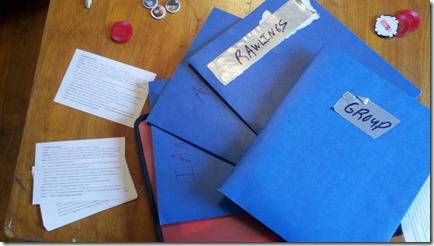


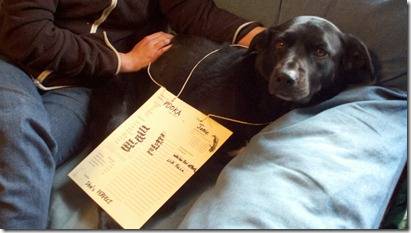
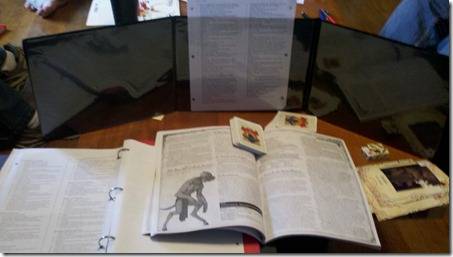




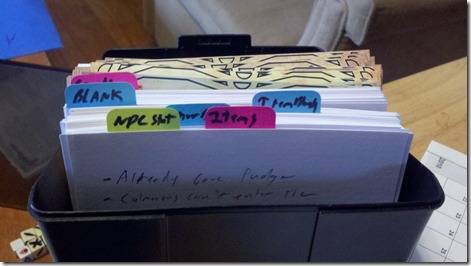
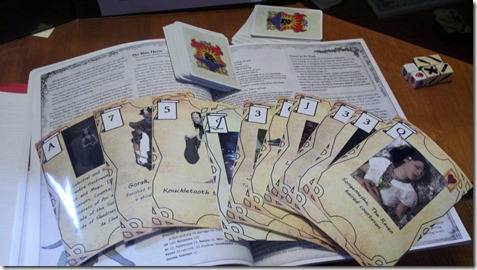
17 Comments To "Meet The Meat Of My Game"
#1 Comment By garden_gm On January 4, 2012 @ 1:08 am
This is great stuff! Thank you for sharing. Which “customizable GM screen” do you recommend?
#2 Comment By Spenser On January 4, 2012 @ 4:58 am
Great article John, and I love the NPC cards! I’ve got a question about the character folders – do the players each hold on to their own folder, or do you keep them and hand them out for each session?
#3 Comment By bighi On January 4, 2012 @ 5:49 am
Wow, you really know how to prepare.
And I like Fate better than Fudge.
#4 Comment By froodbuffy On January 4, 2012 @ 6:46 am
I’m looking forward to the GM organization article. I’d also love to see more about the conversion of 4e to Fudge. I run across a lot of modules I’d like to run, but in different systems, so learning more about conversion would be helpful.
#5 Comment By UrmesKrukudyl On January 4, 2012 @ 6:59 am
Yup, more meat! Meta is nice, but there’s next weeks game and next months campaign to run and this is the kind of article that helps to prepare. Carry on!
#6 Comment By John Arcadian On January 4, 2012 @ 8:20 am
[23] – Thanks! I am using the Savage Worlds customizable screen. My buddy got it for me and it works really well.
Here is the link, but a lot of FLGS’s have this in stock or can order it. I’d check there first so that you can support your local shop.
[24]
[25] – Thanks! The cards are a great addition. They definitely took some time, but the players love them. Even if they can’t remember the name of the person, they can find the card and show it to me or refresh themselves to keep things moving. They leave the folders at my place since they tend to forget things fairly often. In other games we had a “scan your character sheet when you make big changes rule”, since 2 players were horrible about forgetting their characters. I don’t enforce the leave your folders here rule, but it just fits our paradigm.
[26] – Thanks! This game requires a lot of prep. I’ve been considering a switch to the DFRPG the more I read the Dresden Files books. I just don’t have it yet, so I can’t really compare it to the modified fudge I whipped up.
[27] – The GM organization article should be a good one. There are a lot of different ways you can do it, and it often depends on the game system. Prep from 4e to fudge is easy, but that is because Fudge is easy to run on the fly. I’m adding an article on conversions and will use it as an excuse to go pick up some more modules in different systems.
[28] – I’m glad this type of stuff helps!
#7 Comment By Razjah On January 4, 2012 @ 9:11 am
I really liked this article and I look forward to the GM organization article.
I am jumping on the “More Meat” bandwagon!
#8 Comment By macita On January 4, 2012 @ 9:24 am
More of these stuff please … pretty please!
What do I do to keep track of many NPCs:
1) I list the names of the NPCs. One copy for my players and one copy with a lot more information for me. Usually the players start to make notes on their list. This work well for social events with a lot NPCs. As the used lists remain with the players they can check later if they have already encountered someone (and what notes they took at that time).
or 2) I start with only some NPCs and repeat encounters with them until my player know them. One by one I add more people until there might be a quite large NPC group around. This works best for me in city settings (DFRPG, Shadowrun, etc.)
#9 Comment By Palindrome On January 4, 2012 @ 11:42 am
Hey, I hardly ever post (actually, I think this is the second time).
I enjoy a lot of the “meta” articles because I find them inspiring in a big-picture way, which is why I didn’t feel strongly enough to throw my two cents in the State of the Stew thread. But after reading this awesome example of a “meaty” article, I want to say that I’d love to see more articles like this interspersed with the more “meta” ones.
As a pretty newbie GM who is just starting to toy with the idea of running a system outside of d20 (which is what I learned to play on), I find this article incredibly useful. I can learn a lot by reading manuals, etc., but this article helps me actually visualize how a FUDGE game (or any game — I think a lot of the underlying methods and ideas are easily adaptable) might actually look in practice, and it inspires me to try new methods of organization and planning.
Also, thanks for the “firestarters” (I believe that’s the term someone used) at the end of the article. I, for one, will probably post more often if there are questions and requests like that at the end of more articles.
#10 Comment By John Arcadian On January 4, 2012 @ 12:05 pm
[29] – I am now actually hungry for stew with big chunks of beef in it!
[30] – I’m glad you posted Palindrome. I always try to do a firestarter (though I’d never heard the term before) and it is actually one of the things we talk about with the stew. We like the community discussion and we are actually looking at some different ways to allow people to comment more easily. We like to know our stats though, so figuring out a way to do that and stay accurate with how many people are commenting or signing up is bit tricky.
#11 Comment By Tsenn On January 4, 2012 @ 1:47 pm
The only problem is now I feel I should live up to this for my Rogue Trader game, currently being run with combat maps sketched on loose A4 and a blue notebook for keeping track of events and XP!
#12 Comment By JDSampo On January 4, 2012 @ 2:30 pm
I’m starting a new campaign soon and I’m finding stuff like this very inspiring. I think it’s really useful to see how other GMs do what they do. I always learn something. I love the idea of NPC cards for the players.
I’m a big fan of the NPC stat card. We play Savage Worlds and I put each creature, NPC, etc on their own 3×5 card. During the encounter I just lay them out with their initiative cards on top of them. They’re small enough that they don’t take up too much space and everything I need to know is right in front of me.
#13 Comment By Tamerlin On January 4, 2012 @ 4:08 pm
Thank you for the article, as usual there are a lot of things to learn from and medidate on.
How do I organize myself behind my screen? Hum, well… badly and this is also something I am trying to improve these days.
I really like FUDGE but it has been dethroned by FATE (and particularly by a compact stuntless version of FATE 3.0). As I have some trouble to track all the Aspects while playing I have designed a sheet I insert in my customizable screen. But this solution is not fully adequate so I am planning to use index cards (one for each player). Each index cards will hold the Aspects, Consequences and signature skills of one character.
The problem with index cards is that I will get lost if I have too many of them on the table, I know myself so I don’t think this is a solution I can duplicate for the NPCs. I usually group all the NPCs stats on a single sheet.
#14 Comment By randite On January 4, 2012 @ 4:57 pm
I loved the article and look forward to more. Recently I’ve found myself too focused on theory and not focused enough on prepping and running actual games.
I too have found that in more modern settings (pretty much 1900 onward) a calendar is an indispensable aide.
A handy resource for creating calendars with custom time spans is [31] . You can even generate calendars from previous years. The calendars are free, customisable, and include handy info like the phases of the moon and major holidays.
I turned a fellow GM on to the site and the calendar really helped our Modern Urban Fantasy game seem more real (and made the PC werewolf’s player far more conscious of her curse). I intend on using timeanddate.com to make a calendar for a 30’s Noir campaign I’ve been kicking around in the old brain-box for a while.
#15 Comment By J Gregory On January 8, 2012 @ 6:28 pm
Great article – look forward to reading more.
#16 Comment By John Arcadian On January 10, 2012 @ 4:18 pm
[32] – Nothing wrong with that style of organization. If it works for your game, then it works. Also, games don’t necessarily need polished accessories and props to be fun. The game I’m running requires a lot of organizing because it is NPC heavy and I am striving to keep the players on track.
[33] – I like that idea. 3 by 5 never seems big enough to me though. I like having lots of room to work with, but the smaller size would make organizing much easier.
[34] – I’ve had that problem with organizing cards as well. The little box holder and a dollar pack of tabs has really helped. It takes a bit longer at the table to find exactly what I want, but the lack of clutter is worth the minimal time sink, IMO.
[35] – That is an awesome find! I’m going to have to make use of that for my upcoming campaigns!
[36] – Thanks! Glad you liked it. I’ve got to get enough pictures for my index card one, and there are a few handouts I’m making for my organization one.
#17 Comment By Ethalias On January 17, 2012 @ 2:59 pm
Great article. As a long time reader of GM advice, and aspirant GM, who has yet to get a regular game going, seeing the meat, as you put it, is very useful, because I can begin to imagine how I might make my ideas a reality.
Keep up the good work!